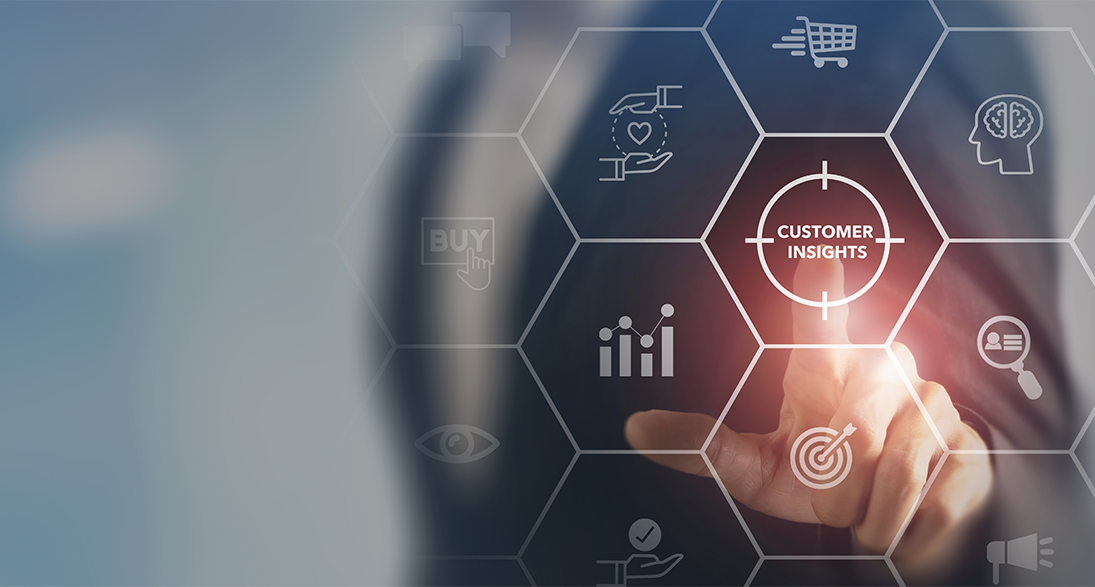UNLEASHING CUSTOMER & DATA INSIGHTS
The 3 Principles to follow and how to put them into practice with AI.

2023
Recognizing that customers are the source of vitality of any business and understanding the relationship between customer value and company profitability has never been more critical to the livelihood and growth of a business. The more a company knows about its customers, the more personalized the experiences it offers, the better it humanizes its operations and processes, and the more competitive it becomes against other organizations.
But how do you communicate this critical message to your peers and how is it best to make your explanation clear, enjoyable, and memorable so that it sticks to them - and they ultimately care?
I’ve recently attended one of the biggest exhibitions on eCommerce & Digital Marketing in Southeastern Europe and had the mission to convey this information across. So I am writing this post to guide you through how I chose to do it and hopefully make it easier for you, if you’re giving such a speech yourself, leading a meeting about Data & Customer Insights or explaining this to your team.

The 3 Principles
There is something magical about the number three. People tend to remember things in threes because it distills a larger message into a recognizable pattern. I am using this technique in the beginning, to talk about the 3 most important principles about Customers & Data, to attract attention and make the audience excited to learn or listen more.
Principle 1: The Pareto Principle (80/20 Rule)
The Pareto principle states that for many outcomes, roughly 80% of consequences come from 20% of causes. In simpler words, the 80% of the results come from the 20% of your efforts.
The 80/20 rule which is considered a universal principle because it applies in so many different cases, was named after the Italian economist Vilfredo Pareto who, in the late 19th Century observed that 80% of the wealth in Italy was owned by 20% of the people. When testing this principle, he also found that 80% of the wealth and land in almost all countries was controlled by 20% of the population (Pareto, 1906). He also found this to be true when he observed his garden, finding that 20% of the pea pods yielded 80% of the peas.
How does this translate to business though?
Similarly, you may find that 20% of your customers contribute to 80% of your total revenue.
Now think for a second, what it would mean to your business if you disappointed and lost one or few of your top customers.
Principle 2: Data is the New Oil
Ah, there is so much to talk about for this famous phrase we have all heard and used so many times … but since not all know or recall its origin, let’s start from there. Before most of us paid attention to data, British mathematician Clive Humby claimed, in 2006, that "Data is the new oil". Humby coined the term, a decade after having launched the world's first data-based consumer loyalty program, Clubcard, at Tesco, Britain's largest supermarket chain.
In his book “Scoring Points”, he explains the compelling and dramatic inside story of how Clubcard was conceived, launched, and developed. He dives into the details of how Tesco found the ways to collect, analyze and use customer data to become a retail giant, at a period that technology wasn’t even close yet to be able to effectively store, manipulate or even allow access to such huge volumes of data - and when real-time processing was hardly feasible. Long story short, Humby and the rest of the team decided to cut data down to size, to study portions of them every week and segment customers by life-stage to predict behavior as a useful start.
ln 2017 the Economist published an article entitled “The world’s most valuable resource is no longer oil, but data” which was considered by many the evolution of the statement. This updated phrase becomes the new tagline with which the Fourth Industrial Revolution is rallying on.
Principle 3: Without data you’re just a person with an opinion.
As the legendary engineer W. Edwards Deming put it, “Without data, you’re just another person with an opinion”. Without insight into data, people make decisions based on instinct, speculation or prevalent theory. Businesses are at risk of acting on biases or false assumptions.
Remember Clive Humby? It is public knowledge that there was a 30-second silence after Humby presented the initial trial's results to the Tesco board, until the then chairman Lord MacLaurin declared: "What scares me is that you know more about my customers after three months than I know after 30 years."
Well, the good news is that organizations today have more data than ever, consequently new facts are generated faster than they are able to be consumed or stored. Data doesn’t always make you smarter, neither collecting all of them will. The only way to solve this problem is to have opinions that can initiate deeper research, drawing on the mass of available data to distill truth and facilitate new learnings.
In other words, the opposite is equally valid today: "Without an opinion to guide you, you’re just another person with data".
Summing up the 3 Principles:
A good tip for enhancing audience’s memory retention is to summarize what you have already described in the form of the most important key takeaways, which, in my instance, were the following:
- 80% of your revenue probably comes from 20% of your customers.
Identify and understand your customers, segment, and focus your efforts accordingly. - Data moves the world now, not oil.
Your competitive advantage and business continuity lies on data. - Data is meaningless without interpretation and context.
Make informed, data-driven decisions.
Lose the Fear - Leverage AI to work for you.
Now comes the hard part. The audience gets excited, you are getting the positive vibes, you feel that there is mutual agreement and confirmation, and then … boom; after a few minutes, you start seeing some faces turned skeptical and sensing a bit of a fear in them. I have seen this a lot, in many presentations and from people from all kinds of company sizes: small, medium, large.
Here is what’s in their minds that moment:
[… “WOW, I know that’s the right thing to do, and I agree with you – I wish I could do it, BUT I do not have the knowledge, I have a small team, I don’t have the resources or the budget etc.…”]
For me, that is a good thing to happen. It is the moment when realization kicks in: recognizing that data is likely underutilized, undervalued and increasingly a proprietary differentiator for the organization.
The fear that accompanies it is also understandable since not all of us are used to work with platforms driven by Artificial Intelligence, that not only boost productivity by eliminating laborious manual analytical tasks, but also connect the dots for smarter, more informed decisions faster.
AI data technologies can empower you to gather, collect, organize, present, and engage with your data with maximum efficiency, which, in turn, will accelerate your commercial growth significantly.

How AI will help you put the 3 Principles into practice
Setbacks are dealt with real solutions. The exciting part of my mission is this one: spreading the knowledge that you do not have to embark on this journey alone.
Artificial Intelligence and a native, AI-powered platform is your ally in translating these principles into practice. With such a tool in your hands, you can automate customer segmentation, predict future behaviors, personalize experiences, forecast sales, and revolutionize reporting. So, lose the fear and let AI work for you, transforming your business into a data-driven powerhouse that thrives in the age of information.
Automated Customer Segmentation with AI
Conventional segmentation approaches come with certain constraints. They frequently depend on fixed, predefined criteria, potentially missing out on changing customer behaviors and preferences. Moreover, manual segmentation procedures can be quite time-intensive or complex and may not fully exploit the wealth of available data.
Automated Customer Segmentation is driven by Machine Learning algorithms that continuously train themselves by processing customers' data and by identifying and analyzing behavior and transactional patterns, enabling marketers to make data-driven decisions and personalize their marketing efforts on a granular level. AI also enhances scalability and efficiency in customer segmentation. It automates the process, replacing manual data analysis and conserving valuable time and resources. By enabling real-time data analysis, AI facilitates adaptive targeting, able to respond to shifting customer dynamics.
Predictive Customer Segmentation with AI
Apart from analyzing historical data, predictive segmentation leverages AI to identify patterns and trends within the data, allowing businesses to anticipate future customer actions and preferences. Machine Learning can predict Customers Lifetime Value, the period of them being active, even when their next purchase will be placed and many more. It empowers businesses to understand their customers better, predict their future behavior, and tailor marketing strategies to individual preferences, ultimately leading to improved customer experiences and increased business success.
Dynamic Personalization
By taking advantage of the Automated Segmentation, a website or any digital application can dynamically personalize its content, promotions and strategy based on individual visitor preferences and behavior. Businesses can enhance the user experience, increase engagement, and drive conversions by serving tailored content, recommendations, and offers.
AI Sales Forecast
AI can forecast sales by analyzing historical sales data, identifying patterns, and using predictive algorithms to make accurate predictions about future sales trends. Accurate sales forecasts help businesses optimize their inventory levels, reducing excess inventory costs while ensuring products are available to meet demand.
AI Powered Reporting
AI-powered reporting refers to the use of Artificial Intelligence and Machine Learning technologies to automate and enhance the process of generating insights from data. This approach revolutionizes traditional reporting by making it faster, more accurate, and more insightful.
Anomaly Detection
AI can automatically detect anomalies or irregularities in data, which is essential for identifying potential issues. This allows organizations to take immediate action when necessary.
Conclusion
Embracing the three fundamental principles outlined in this article (and in my presentation), is not just some advice; it’s a vital learning for thriving in the Digital Age. Understanding the influence of the Pareto Principle, acknowledging the value of data as currency, and grasping the interdependent nature of opinions and data are crucial for driving significant business transformations. These principles aren't abstract concepts; they are practical guidelines that, once grasped, can reshape strategies and facilitate exceptional growth.
And, remember, in this age of information, it’s not about the volume of data you possess; it’s about the wisdom you extract from it. So, embrace the possibilities, and let AI empower you to turn insights into actions, aspirations into achievements, and challenges into triumphs. Your journey to data-driven excellence begins now.
Have you checked out A-commerce, ATCOM's Unified Commerce Platform?

